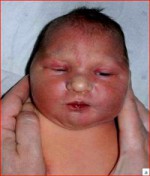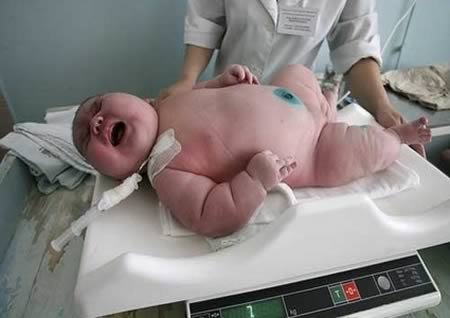The maximum weight of a newborn. Features of the birth of a large child
It is believed that the birth of a large baby should be a joy for parents, proof of his health and strength. But obstetrician-gynecologists do not share such euphoria - because they know that being big is not necessary at all. healthy child, and childbirth, when the fetus exceeds 4 kg, is more difficult.
What does the expression "big baby" mean, and what can contribute to its birth?
When can I find out the size of the fetus?
First of all, you need to make a reservation: a large fruit weighs 4-5 kg, a giant one - more than 5 kg. The growth of such children usually ranges from 54-56 cm. Now the percentage of large children born to total mass newborns is about 10%. "Giants" are born much less frequently.
When can you determine whether you will have a "hero"? Such a forecast can be made no earlier than the middle of the third trimester. If at this time your waist size exceeds 100 cm, the probability of having a large child is high. A doctor's examination and ultrasound will more accurately determine the size of the head, abdomen and circumference chest Your child.
Your weight gain schedule, which you can keep from the beginning of pregnancy, can also tell about the possibility of the birth of a “hero”. A normal increase up to 20 weeks is no more than 700 g / week, from 20 to 30 weeks - no more than 400 g / week, and after 30 weeks - no more than 300-350 g / week. If you add more, you are either too fond of high-calorie foods, or you carry a “hero” under your heart. In total, normally, a thin woman can add up to 15 kg over the entire pregnancy, a woman with an average physique - up to 12 kg, and a "dumpling" - no more than 7 kg. If the weight is gained more than the norm, but the woman has no signs of preeclampsia, this may be a sure sign that a hero will be born.
In addition, there is a special plate that indicates approximate weight fetus by week - the doctor will probably use it to determine how big the baby is growing in your stomach. As a rule, in "heroes" the size of the fetus is 2 weeks ahead of the norm.
Reasons for the birth of large children
There are certain risk factors that contribute to the birth of large babies: overnutrition during pregnancy, endocrine diseases, heredity, overmaturity, placental features and some other factors.
1. Overnutrition during pregnancy. Nutrition during pregnancy is essential nutrients enough for you and your child.  All excess calories will be deposited not only on your body, but also on the body of the child - he will also "get fat with you for company." This is especially true in the second half of the third trimester, when the child is gaining muscle mass. You should be especially concerned if you eat a lot, but you do not have edema - probably, the main calories are aimed specifically at increasing the weight of the child.
All excess calories will be deposited not only on your body, but also on the body of the child - he will also "get fat with you for company." This is especially true in the second half of the third trimester, when the child is gaining muscle mass. You should be especially concerned if you eat a lot, but you do not have edema - probably, the main calories are aimed specifically at increasing the weight of the child.
2. Endocrine diseases(diabetes, obesity). Since the metabolism (especially carbohydrates) is disturbed in diabetes mellitus, they usually pass through the placenta directly to the fetus, causing it overweight and, as a rule, a disproportionate physique.
Obesity (moreover, of both parents) leads to similar consequences: violation carbohydrate metabolism and, consequently, an increase in fetal weight.
3. Heredity. If both parents are large, tall, with strong figure- the baby may well go in them. In addition, if you yourself were born more than 4 kg or you already had large children, there is a high probability of a re-birth of the “hero”.
4. Overwearing. If the child is overdue, he may have signs of the so-called "overmaturity": an increase in body length, head volume, skull bones become denser, sutures and fontanelles are less extensible, which can complicate the course of childbirth.
5. Features of the placenta. A large fetus can form if the placenta is very dense and thick, and its volume and size are also exceeded. In this case, there is a more intensive exchange and accelerated development fetus. In addition, due to a large placenta, hormonal background in the mother's body, which also leads to accelerated growth fetus.
Accelerated development of the fetus is also facilitated by the location of the placenta along back wall uterus, as in this position the blood flow is accelerated - and the intensive blood supply to the fetus contributes to its growth. The same effect can be long-term use drugs that improve uteroplacental circulation.
6. Some other factors. Also, a large fruit can be:
- male;
- in young women (up to 20 years old) and in mature women (after 34 years old);
- women who have inflammatory diseases female organs in the past;
- in women with menstrual irregularities.
What is fraught with the birth of a large fetus?
childbirth large fruit in most cases proceed normally if a woman has normal pelvis and she does everything right. But they may also have some features that you need to be prepared for in advance: 
- weakness labor activity which contributes to the slow opening of the cervix. This is because the uterus is overstretched to hold such a large fetus - and therefore cannot contract properly;
- untimely release amniotic fluid- before the onset of labor or before the opening of the cervix. This is due to the fact that the fetal head is high in the pelvis, and the waters are not divided into anterior and posterior, as occurs in normal physiological childbirth. Untimely outflow of water also contributes to the difficult opening of the cervix;
- a long second stage of labor due to the slow opening of the cervix and the large head of the fetus, which is difficult to move through the birth canal. In addition, if the fetus is overdue, it is already hard and difficult to adapt to the birth canal;
- fetal hypoxia, which can develop due to weak labor, delayed labor and premature outflow of water;
- a situation of a clinically narrow pelvis, implying a mismatch in the size of the head and shoulders of a strong man even normal size mother's pelvis. In such a situation, there is a possibility birth trauma child, as the hangers seem to “get stuck” in birth canal. But usually, if there are no special complications and the doctors act professionally, such childbirth ends normally;
- an increase in the risk of birth injuries in parturient women: perineal ruptures, uterine ruptures, urogenital fistulas and others. That is why in childbirth with a large fetus, cases are so frequent surgical intervention. After all, if there is a threat of uterine rupture, the issue of an emergency caesarean section is immediately resolved. And if there is a threat of perineal rupture, an episiotomy is done. This is a very neat incision, which is then sutured and after a while it becomes completely invisible.
Complications after childbirth
- after childbirth, bleeding may open, so a woman who has given birth to a large child should be observed by doctors especially carefully;
- manual examinations of the uterus are possible in order to remove the remnants of the placenta;
- a woman may become anemic, obese women- blood clots, inflammation of the mucous membrane of the uterus and genital tract, delayed involution of the uterus;
- as a result of childbirth, the fetus may experience neurological disorders, so it should be examined by a neurologist;
- possible state primary immunodeficiency, which provokes various purulent infections and increased morbidity of the child;
- children born large may be prone to obesity, diabetes, neurological problems, allergic reactions etc.

Prevention of complications at the birth of a large child
If you have found a large fetus, you need prenatal hospitalization and delivery under careful monitoring of the condition of the woman in labor and the child. In addition, before childbirth, it is necessary to take antispasmodics, painkillers, vitamins, and conduct labor-stimulating therapy. If the fetus is too large and the pelvis is narrow, a planned caesarean section is scheduled.
In order to prevent bleeding immediately after childbirth, a woman must be given a drug that reduces the uterus and put a dropper with a drug that stops bleeding. The child also needs to be monitored, even if he was born outwardly healthy.
If a woman has obesity, diabetes mellitus and other risk factors, they prevent the formation of a large fetus for another early dates pregnancy.
In any case, if you were told that you are waiting for a "hero" - do not be afraid and start expecting the worst. If you take all measures in advance so that the birth goes well, you simply cannot have any huge problems and fears!
Heroic children are the joy of grandmothers and a reason for the pride of parents. Unfortunately, this is not always the case. Why are big babies born, and what dangers can await them?
What does "large fruit" mean?
There are several situations in which doctors call babies large:
1. Babies born with a body weight of 4 kg or more are considered large. In this case, the baby can be 36 - 42 weeks old (, full-term or post-term), that is, the gestation period does not have crucial. Today, about every sixth newborn is born large, and rare (less than 1%) heroes are giant, that is, with a birth weight of 5 kg or more.
2. In the second half of pregnancy, during any planned measurement of the circumference of the abdomen and the height of the uterine fundus, in the expectant mother, the gynecologist may suspect that the fetus is large. This happens if the numbers obtained on the centimeter tape are 3 or more cm higher than the approximate average value (obstetricians have special tables and calculation formulas for each week of pregnancy). This means that the young stubbler is already 2 weeks or more ahead of his peers in terms of physical development. Since every day matters for the period of intrauterine life, this difference is considered quite tangible. By the time of childbirth, the “waist” circumference at the level of the navel will be more than 100 cm (meters!), And the bottom of the uterus will be higher pubic bone 42 cm or more.
An additional argument in favor of a large fruit is more than 500 gr. in Week. But the doctor can only assume that the baby began to gain weight too actively, because the body weight and size of the pregnant tummy can grow only in a woman (for example, with edema or polyhydramnios). Ultrasound will confirm suspicions.
3. During the ultrasound. The first trimester of pregnancy is the period when all organs are formed in the fetus, and he literally “does not care for fat”. Build muscle mass and adipose tissue he starts from the second trimester, most actively in the third. Therefore, most mothers will first hear that their baby is large (tendency to a large fetus), from about. Just at this time, the second planned ultrasound is performed, on which the doctor will definitely calculate the weight of the baby by measuring his length femur, circumference of the head and tummy (again according to special tables or using the program - in new ultrasound machines).
But there are separate young accelerators who confuse doctors with their heroic dimensions already at the first, genetic ultrasound. Then the question usually arises about the correctness of the calculation of the gestational age by the mother herself, about the accuracy of her registration of the start date. last menstrual period or day of conception. In such cases, the expected date of birth is indicated by ultrasound (exactly in time), and then they write the second digit, calculated according to the woman indicated menstrual cycle. There are no special reasons for excitement, since a 2-week run is considered acceptable, especially since the baby looks larger, and not smaller than expected.
Top Reasons Why Babies Are Born Big
1. Acceleration
Do you think only teenagers strive to overtake their parents in height? No: baby-belly babies have been born bigger and bigger for many years. Therefore, a woman must be prepared that her full-term babies will be heavier at birth than she and her husband on their birthday.
2. Heredity
It has been noticed that a fragile mother, especially a young one (up to 20 years old) or an old one (after 34 years old), is much more likely to grow a hero in her tummy if the spouse was born large at one time. And if a woman was also not small in infancy, then the baby will become just a giant.
In overweight daddies who grow their tummy along with the future mother, little ones are also often born heroes.
It's not just about genetics physical development crumbs. Indeed, often babies, large at birth, are compared in weight and height with their peers at kindergarten age, or even much earlier. matter hereditary features metabolic activity in the body of the mother and baby, the structure of the placenta itself or its vascular network (it will be more abundantly supplied with blood or have larger dimensions).
3. Overwearing
With a prolonged or delayed pregnancy, a small belly maker will definitely use the opportunity to grow up while the mother's body is preparing for childbirth. After all, even before 14 days you don’t have to strain to suck, breathe, scream and recover yourself - know yourself fat!
4. Irrational nutrition of a pregnant woman
Expectant mothers in the second half of pregnancy are forced to limit their physical activity. At the same time, few manage to reduce their diet a little: here at least cope with increased appetite. So imperceptibly, an excess of calories appears, adding extra pounds to mom and her belly button.
A separate problem is refined sweets, and pastries made from premium flour. Not only does their irrepressible eating increase the risk of gestational diabetes, but sugar is no worse than salt, provokes the occurrence of edema. Hence the overweight and rather large dimensions of the pregnant woman and the heir.
It has been noticed that with obesity of the 1st degree, about a quarter of women give birth to large, often healthy, children. But then - with each overweight in mother - the proportion of heroes increases slightly, but the risk of developing dangerous diseases in the fetus and injuries in childbirth in both increases many times.
5. Repeated births
In the same pregnancies, each next child will be born larger than the previous one. Everything is explained by the readiness of the mother's body for bearing and the hormonal and physiological changes associated with it. But this will be so only in those cases when between childbirth a woman has the opportunity (time, quality food) to fully recover. Otherwise, the mother risks giving birth to a small child and suffering from polyhypovitaminosis for a long time, the symptoms of which will be thinning hair, fallen fillings in the teeth, exfoliated nails, dry skin, a dull look, endless fatigue and postpartum depression.
6. Diabetes mellitus, which mother suffered before pregnancy, as well as

There is whole complex signs in infants called diabetic fetopathy. In fact, these are the consequences of hormonal shocks and jumps in blood sugar levels in the mother. Among them, one of the earliest and most common is an excessive increase in fetal weight after 20 weeks of gestation in combination with polyhydramnios.
7. Edema in a pregnant woman for various reasons
While the baby is in the mother's tummy, he is inextricably linked with her, part of her. Therefore, everything that happens to her, necessarily affects the belly. And if a woman appears, they will also have crumbs. So it will weigh more.
But there is important differences, which must be remembered: when a pregnant woman has edematous fluid accumulates only in subcutaneous tissue legs, in a baby it is distributed throughout the body, including in the lungs, in the heart and in the brain, disrupting the work of all organs and preventing it from starting full life after birth. The placenta also gets a lot: due to edema, it thickens, the blood supply in it is disturbed, and the fetus receives less oxygen. That is why a large weight gain in the fetus with edema in his mother is a reason for excitement and active treatment.
8. Hemolytic disease intrauterine
The edematous form of incompatibility according to the Rh factor of the mother and fetus is the most severe and prognostically very dangerous form hemolytic disease. Treatment of a newborn baby is a huge and often fruitless work. Therefore, doctors are doing their best to prevent its development, actively observing Rh-negative pregnant women and taking them a set of protective measures.
9. Iatrogenic
This is a mother-to-be medicines contributing rapid growth fetus or accumulation excess fluid. These are corticosteroid and female sex (gestagens) hormones, glucose, anabolic steroid, excessive passion for drugs that increase blood circulation in the placenta.
How is pregnancy with a large fetus

The first half of pregnancy has no differences. Unless the tummy will become noticeable a little earlier, and even then in women with a narrow pelvis. Mom needs to be prepared for the fact that as soon as doctors see a trend towards a large fetus, she will have to go for ultrasound more often and do a few additional ones, first of all, blood for sugar and a glucose tolerance test. The main recommendation a doctor observing a pregnant woman will eat right, not “lean” on sweets and fatty foods.
In the second half of pregnancy, when the cause of the development of a large fetus has been clarified, some mothers will be offered inpatient or ambulatory treatment. Most of the little heroes will just have to listen more often and with her reminders of the need to observe moderation in food.
How will it feel future mommy? She will feel her bugbear sooner than the others. The jolts will not be gentle and timid for long: very soon she will have to wait until her football player has played enough and stops kicking her noticeably in the ribs. Moreover, girls will frolic no worse than boys. In heroic mothers, shortness of breath also begins more often and earlier due to compression of the stomach and diaphragm by the uterus. Often they are concerned about swelling and varicose veins in the legs and hemorrhoids due to the slowdown in the outflow of blood from the lower body through the vessels pressed by the uterus. There may be pain in the sacrum due to hyperextension of the lower back, pain and cramps in the feet and in calf muscles with a large increase in weight and with a lack of nutrition in a pregnant woman. For many, it occurs, due to which the pregnant woman will not be able to sleep on her back and will feel short of breath and dizzy during examinations in the supine position (ultrasound, examination in the gynecological chair).
There is one funny moment: until the last moment, you can keep the intrigue and smile mysteriously instead of answering the question of the curious about whether twins are expected.
Hello everyone, I'm with you again and today we'll talk about babies who have become record holders, having been born with an abnormally large weight. So, as you may have guessed, the following question is on our agenda today: how much does the most big newborn child in the world.
Little record holders
Everyone knows that the normal weight for a child is 3 kilograms, with a deviation of 500 grams in both directions. However, sometimes peanuts are born who “break all records”, exceeding the norm by several times with their weight. One of these chubby unique babies was a native of central China, the city of Xinxian (Henan Province).
Chong Chun (that's the name of the baby) is the largest baby in the world. His birth weight reached 17 kg 400 grams and was officially listed in the Guinness Book of Records as the largest living baby.
It's hard to believe, but China is a country - a leader in the number of births of large little peanuts. Even before the birth of Jung Chun, three seven-kilogram crumbs were born here, and this is only in the period from 2008 to 2010. The strong man's mother, 29-year-old Wang Yujun, while still pregnant, already felt that she had an unusual baby in her tummy. Jung Chun's parents already have a six-year-old daughter, who, at one time, was also born quite large - 4 kilograms.
 However, not only in China there are "heroes". We also have peanuts - strong men who can rightfully be considered "heroes". For example, in Russia, on February 29, 2012, in the Altai Territory (village of Protasovo), in the Titov family, by cesarean, a hero was born, weighing 7 kilograms 850 grams. This is the largest baby in Russia. His mother, 42-year-old Svetlana Titova, is already the ninth toddler. Their family is quite religious, and they believe that the child has become a reward for them, a kind of "gift from above." Before him, in Altai, with a slightly lower weight (7 kg 750 g), only a girl was born - Nadezhda. This event took place on September 17, 2007.
However, not only in China there are "heroes". We also have peanuts - strong men who can rightfully be considered "heroes". For example, in Russia, on February 29, 2012, in the Altai Territory (village of Protasovo), in the Titov family, by cesarean, a hero was born, weighing 7 kilograms 850 grams. This is the largest baby in Russia. His mother, 42-year-old Svetlana Titova, is already the ninth toddler. Their family is quite religious, and they believe that the child has become a reward for them, a kind of "gift from above." Before him, in Altai, with a slightly lower weight (7 kg 750 g), only a girl was born - Nadezhda. This event took place on September 17, 2007.
Are babies strong or is it difficult to give birth to a “hero”?
Unfortunately, such "gifts of nature" have their own specific difficulties and problems. The health of such children is most often threatened by the development of certain "occupational" diseases. For example, large newborns are more likely than others to suffer from diabetes, are more susceptible to allergies and neurological disorders. This happens because they muscle tone significantly different from the norm.
Another very important issue are childbirth. The birth of a large baby is a huge burden on the mother's body, not to mention the fact that during childbirth, both mother and baby experience tremendous stress. And this is all with normal weight! And imagine that the weight of your baby, which you carry under your heart, is 7, 10 or 17 kilograms?! emotional and exercise stress In this case, it will increase exponentially!
 Naturally, with such a large size of the fetus, it will be almost impossible to give birth on your own! What to do in this case? The conclusion is simple: caesarean section. Such an operation can save the life and health of both mom and baby. It is performed by removing the newborn through an incision in the uterus.
Naturally, with such a large size of the fetus, it will be almost impossible to give birth on your own! What to do in this case? The conclusion is simple: caesarean section. Such an operation can save the life and health of both mom and baby. It is performed by removing the newborn through an incision in the uterus.
That's all, my dears. Today, your baggage of knowledge has become an order of magnitude greater. I hope my post was helpful to you. Read my other articles, subscribe to the blog, feel free to leave comments and ask questions.
That's all.
Until new articles!
The birth of a child weighing more than 4 kilograms is enough a rare event, but these kids broke all records!
1. Jasleen - the most big baby in Germany
In 2013 natural way a child was born weighing 6.1 kilograms and 57 centimeters tall. Baby girl Jaslyn was born at the University Hospital in Leipzig, Germany on July 26 and became the record holder for the largest size in the whole country.
Jaslyn's mother, as it turned out, suffered from diabetes pregnancy, a condition that usually appears around the 24th week of pregnancy and can lead to unusually large newborns.
2. Stephen Little is the largest child in Australia
Stephen Lyttle, who weighed 7,399 kilograms when he was born at Kempsey Hospital on January 26, 1963, was the largest child in Australian history. The average weight of newborns is 3.37 kilograms.
On the this moment he is 50 years old, his height is the usual 186 centimeters, and his weight also does not differ much from the norm - 97 kilograms.
3. Maxine Marin - gave birth to the largest girl in Spain
A 40-year-old woman from Britain gave birth to the largest child born naturally in Spain - a girl weighing 6.2 kilograms. Maxine Marin gave birth at 4:43 am local time at the Hospital Marina Salud in the Mediterranean city of Denia.
Larger babies were born with caesarean section, but Marin didn't even need an epidural (a painkiller injected directly into her spine during childbirth).
Marin, who lives in Spain with her Colombian husband, said she expected big baby, but "not that big".
4. George King is the largest child in the UK
The largest baby born in the UK is George King, born this year. The child weighed 7 kilograms, which is almost twice the average weight of a child.
There was no indication that George would be that big: both of his parents were regular size and in adulthood, too, do not differ in special height or weight.
George's size caused considerable difficulty for his mother, Jade. During childbirth, after the newborn's head had already left the mother's body, it got stuck. Its relatively big sizes for the newborn caused that his shoulders could not pass further.
According to Jade, "then it became very scary" as almost 20 paramedics worked to release the child. In the end, George was born successfully and was transferred to another hospital for further observation.
5. JaMichael - the largest child in Texas 
In 2011, Janet Johnson gave birth to a boy who appeared on the world with a weight of 7.2 kilograms, which is twice the average weight newborns. Baby JaMichael was the heaviest baby ever born at the Good Shepherd Hospital in Longview, and by some accounts the largest newborn in the entire state.
Johnson and her fiancé, Michael Brown, knew the baby was going to be big. Two weeks before the birth, which took place by caesarean section, Dr. John Kirk (John Kirk), gynecologist Johnson, said that the baby will weigh 5.5-6 kilograms. However, JaMichael surprised even the doctor.
6. Nadia Khalina 
Nadia, who weighed 7.75 kg at the time of birth, is captured in a photograph lying in maternity ward hospitals in the Siberian city of Barnaul on September 26, 2007. Mother from Siberia made literally a big contribution to correcting the demographic situation in Russia. Tatyana Kharina shocked her husband by giving birth to Nadya, her 12th child.
7. Newborn weighing 8.7 kg from Indonesia
This four-day-old baby, weighing 8.7 kilograms, sleeps among medium-sized children at the Abdul Manan General Hospital in Kisaran, Asahan district, North Sumatra province. He was born on September 21, 2009. An Indonesian woman gave birth by caesarean section to a baby weighing an average weight one year old baby.
8. Stephon Hendrix Louis-Jean (Stephon Hendrix Louis-Jean) - a newborn boy with a height of 58 centimeters
Marie Michel's fifth child held the record. In 2011, Michelle gave birth to a boy weighing 6.7 kilograms at the William Backus Hospital (William W Backus Hospital).
Hospital officials said the newborn, Stephon Hendrix Louis-Jean, broke the 18-year record for the heaviest newborn, beating the previous record holder by 822 grams. The boy's height was almost 58 centimeters.
The size of the child did not surprise the mother. Michelle's eldest son weighed 4 kilograms, her eight-year-old twins each weighed 3.8 kg, and the youngest, a three-year-old boy, almost 5.5 kilograms.
9. Ademilton dos Santos - the most large newborn in Brazil
In 2005, a Brazilian woman gave birth to a "giant baby" weighing 8 kilograms, twice the weight of an average newborn. Ademilton dos Santos, according to the Association of Gynecologists of Brazil, is the heaviest boy in the history of Brazil
Ademilton was born by caesarean section at a Salvador hospital in northeastern Brazil. This is the fifth child of Francisca Ramos dos Santos and doctors believe the boy's unusual size was due to his mother's diabetes.

